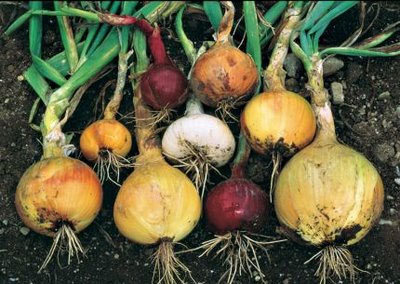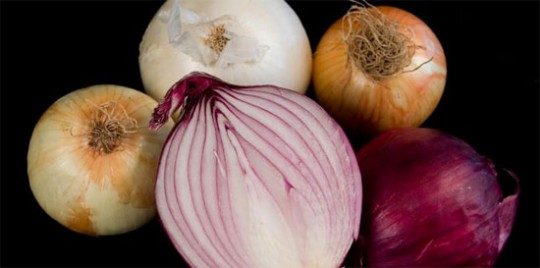Weekend Gardening: Now’s The Time To Plant Onions
September 27, 2014
by the Santa Rosa Extension Service
Onions are sold in every grocery store, served at many meal and featured at sporting events across the United States. Onions are everywhere. If you’ve ever wanted to try to grow them, now is the time to plant.
Edible onions have been cultivated for so long that it is difficult to trace their origin. Onions were first introduced to America around the turn of the century when a retired French soldier brought some onion seeds from Corsica to the Walla Walla region of the Pacific Northwest. But it wasn’t until the farmers in Georgia realized what a special thing they had in the Vidalia onion and began spreading the news that the sweet onion finally got the attention it deserves.
Onions have different requirements as to the number of hours of daylight required for bulb formation. The types that require 15 to 16 hours of light daily are referred to as “long day” varieties and not adapted for the South. Types that grow best in Florida are the “short-day” varieties. They must be started in the fall so that bulbing is induced by the short days of winter. However, the subsequent harvest of bulbs follows in the spring or early summer.
Onions are often grouped according to taste (mild and strong flavored), color (white, yellow, and red) and use (storage or freshly eaten). Some suggested bulbing onion varieties for Florida include Excel, Texas Grano, Granex, White Granex and Tropicana Red.
Yellow onions are gardeners’ most popular choices. Granex 33 is the early Texas hybrid grown in Vidalia, Georgia. Texas Grano 1015Y Aggie Sweet produces a large, mild bulb that is very sweet under the right growing and soil conditions. The Texas Grano 502 is well known for large, mild bulbs with fair storage potential.
Onions are grown either from seed, sets (tiny immature bulbs) or transplants. The planting method selected is based on cost, use, availability, and planting ease.
 Onions grown from sets do not make the best bulbs, and are rather costly. Specific onion varieties are usually not available. They are sold simply as red, white, or yellow onion sets. Since the variety is unknown, the flavor, use, and keeping quality of onions grown from sets varies considerably. Avoid sets more than an inch in diameter, as they are likely to bolt. Late plantings are more susceptible to cold or freeze injury. Planting too early can result in increased seed stem production.
Onions grown from sets do not make the best bulbs, and are rather costly. Specific onion varieties are usually not available. They are sold simply as red, white, or yellow onion sets. Since the variety is unknown, the flavor, use, and keeping quality of onions grown from sets varies considerably. Avoid sets more than an inch in diameter, as they are likely to bolt. Late plantings are more susceptible to cold or freeze injury. Planting too early can result in increased seed stem production.
Growing onions from seed may be the most difficult planting method. However, it is the least expensive and offers the greatest variety. Germination may be sporadic and plant growth can be slow. Be aware that onion seed does not remain viable long, and should not be planted when more than one year old.
In North Florida, onions can be started between mid-September and mid-November. Onion seed can be planted directly in the garden or in flats. Sow eight to 12 seeds per foot of row ½ to one inch deep. If larger bulbs are desired, thin to a final spacing of four to six inches apart.
Set out transplants from late December through February. Plants should be about 6 inches high and about half the thickness of a lead pencil at the time of transplanting. Set plants with the bottom of the plant about 1 to 1½ inch below the surface of the soil. Transplants should be spaced 3 to 4 inches apart in the row.
Onions have a shallow, poorly developed root system, so regular fertilization and watering are essential. Inconsistent watering may lead to splits, doubles and small bulbs. Fertilize the crop monthly with a nitrogen fertilizer. Be sure to keep the fertilizer from contacting the plants directly.
Good weed control is a must. Since young onions are small and grow slowly at first, they can be taken over by weeds that reduce yield. Look out for diseases before they become established. Leaf blight diseases can seriously reduce yields. Monitor for insects twice each week, and use appropriate management techniques. Contact your local Extension Office for the latest information on pest management recommendations.
Comments
4 Responses to “Weekend Gardening: Now’s The Time To Plant Onions”




>>Definitely need more articles like this one … year round.
We do publish a gardening article *almost every weekend on a variety of local topics.
Definitely need more articles like this one … year round.
Garlic is easy to grow as well this time of year
Very informative article. I’d like to see more like this. Tomatoes, okra, squash,
butter beans…. Onions all go with them. Tell us how to grow these too~!
Thanks!